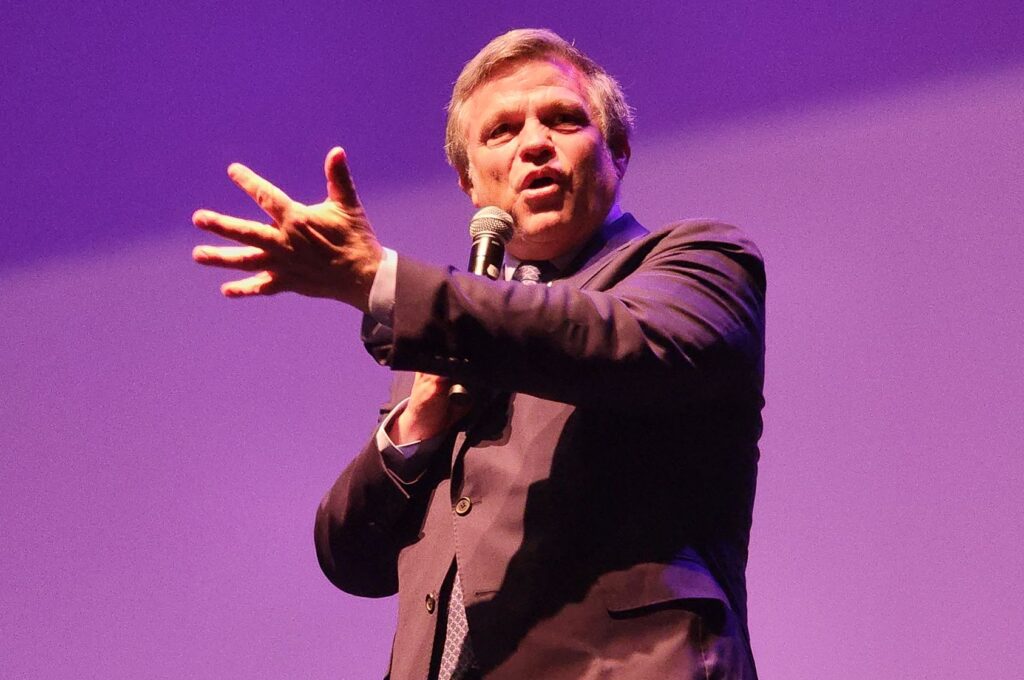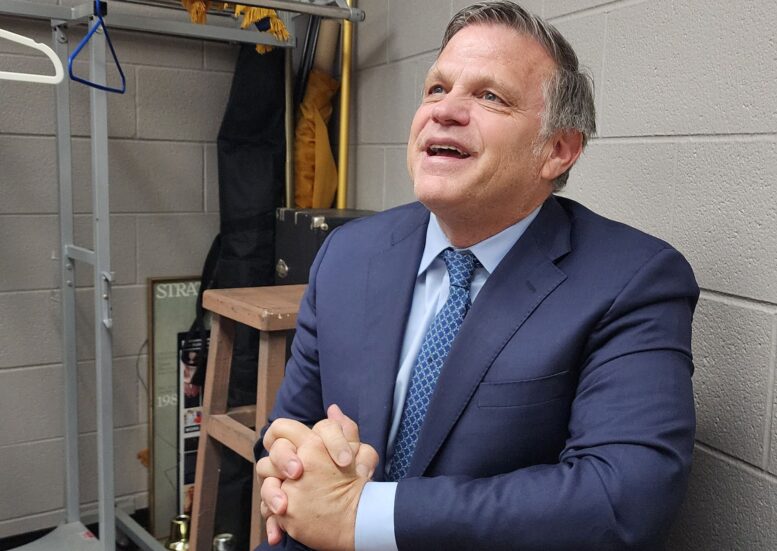By JAN McLAUGHLIN
BG Independent News
As he waited backstage, the historian who has authored several books on past U.S. presidents, turned his attention to the current commander in chief.
An historian who values accuracy and unvarnished stories of America’s past, Douglas Brinkley worries that this period in history is losing its grasp on reality.
“I’m deeply troubled by our age of misinformation,” Brinkley said Thursday evening as he waited to speak at a lecture hosted by the Country Garden Club of Perrysburg. “People just make things up” with the focus on “who says the most vulgar thing and gets the most clicks.”
Brinkley is a history professor at Rice University, CNN presidential historian, and a contributing editor at Vanity Fair. The Chicago Tribune dubbed him “America’s New Past Master,” and the New York Historical Society has chosen Brinkley as its official U.S. presidential historian.
His stop in Perrysburg came a day after speaking in Sacramento, and a day before heading east to New York for an interview with Judy Collins, followed by a stop in New Jersey at the Bruce Springsteen Archives.
The visit to Perrysburg was a homecoming for Brinkley, who spent most of his childhood here. Born in Atlanta, Brinkley’s family moved to Perrysburg when he was 8. His father was a Corning Glass executive, and his mother was an English teacher.
Later in the evening Thursday, as Brinkley took the stage, he called out to former classmates in the audience from the Perrysburg High School Class of 1978.
Brinkley doesn’t remember a time when he wasn’t intrigued by history. By age 8, he had the names of all the U.S. presidents memorized. A year later, he mastered the vice presidents as well, soon to be followed by the losing candidates who ran against them.
Brinkley has written two books on John F. Kennedy, his favorite president – not because he was the best president but because of his extraordinary efforts to unite the country through advancements in space.
“My childhood was wrapped in that,” Brinkley said.
Other presidential favorites include Teddy Roosevelt, Franklin D. Roosevelt, and Ronald Reagan. Donald Trump was not on his list.
“I thought he was going to be a one-time outlaw asterisk president,” especially after the Jan. 6 riot on the Capitol. “He’s doing some large ‘reforms’ that feel like a wrecking ball.”
The U.S. has lost much of its standing in the world, and the American people aren’t feeling the economic relief that was promised, Brinkley said.
“I don’t feel our democracy is dead,” he said. But Americans need to get more engaged to challenge unregulated technology, climate change and broken politics. He fears the long-term damage of the nation’s leadership straying from the policies of presidents who tried to be good stewards of water, land and air.
“I’m afraid Trump wants to gouge everything now with ‘drill, baby, drill,’” Brinkley said. The U.S. should be prepared for a lot of lumbering and big pipelines stretching across the nation, he said.
As a conservationist who has written extensively on natural places and animals, Brinkley is troubled with this direction – especially as more extreme weather events are occurring.
“I see myself as a protector of our 550 national wildlife refuges,” he said.
Brinkley is also concerned about the return to the 1890s era of “robber barons,” who became rich industrialists by using ruthless business practices. Trump has repeatedly praised those practices, while disparaging public servants and allowing them to be callously fired, Brinkley said.
“He prefers people who are rich and famous,” he said of Trump. Instead of industry leaders, it’s now tech leaders who are the darlings of the administration.
“We need leadership that’s willing to hold tech in check,” Brinkley said.
As he travels across the nation, Brinkley continues to write books – with his curiosity adding to the topics.
“I’m always writing,” he said.
His book “Cronkite” won the Sperber Prize while “The Great Deluge: Hurricane Katrina, New Orleans and the Mississippi Gulf Coast” received the Robert F. Kennedy Book Award. His two-volume annotated “The Nixon Tapes” won the Arthur S. Link – Warren F. Kuehl Prize. He’s authored books on World War II, Rosa Parks, Henry Ford, Rachel Carson, and John Kerry in the Vietnam War.
Next on his list is the history of Route 66, as it stretches from Chicago to Santa Monica, California. He’s also hoping to write about Bill Clinton, and another book on Jimmy Carter.
Though books on presidents are his “main bread and butter,” Brinkley’s inquiring mind has added the Panama Canal and George Washington Carver to his list. A big fan of jazz, blues and country music, he is also planning to write a book on Bob Dylan.
He’s toyed with writing a book on Ohio being the “mothership of presidents,” with seven being born in the state. And maybe one on William Henry Harrison, who was in Perrysburg in 1840 when he found out he had won the presidency.
Trump was not on Brinkley’s list.

Once Brinkley took the stage, his lecture focused on conservation. He has been actively involved in the environmental conservation and historic preservation community. He has held board or leadership advisory roles in support of the American Museum of Natural History, Yellowstone Park Foundation, National Audubon Society and the Rockefeller-Roosevelt Conservation Roundtable.
The first president to actively defend America’s natural areas was Teddy Roosevelt, Brinkley said. When Congress wanted to mine the Grand Canyon, Roosevelt used the Antiquities Act to preserve dinosaur bones and Native American artifacts. He was able to protect one million acres in the name of science.
That was followed by other rescues of areas like the redwoods in California and Crater Lake. Upon learning of the “wholesale slaughter of migratory birds,” in order to provide feathered hats for women, Roosevelt went on to create 550 wildlife refuges.
That was the first time the government gave animals more rights than humans in certain areas, Brinkley said.
Roosevelt eventually saved 234 million acres, created the U.S. Forest Service, and dedicated 130 national forests. That act deemed areas as public lands, “instead of allowing all of the country to be commercialized or paved.”
The second wave of conservation in America came from Franklin D. Roosevelt, who created 800 state parks during the New Deal. Clear cutting of hardwood trees had led to drought and the dust bowl across the plains.
“That was a huge eco-catastrophe,” Brinkley said. The Civilian Conservation Corps was created, and FDR’s “tree army” planted 3 billion trees across America.
The next environmental awareness era began with Rachel Carson, a marine biologist and writer. She authored books about the ocean, and “Silent Spring,” about the harmful effect of insecticides on wildlife. After more than 1,000 nuclear bombs had been tested in the U.S., Carson was also among the women demanding the end of nuclear testing above ground and underwater.
Based on research by Carson and others, President John F. Kennedy got Russia and Great Britain to join the U.S. in signing a nuclear test ban treaty.
Carson was the driver behind the effort to ban the pesticide DDT. While it was a “miracle chemical” when protecting humans from mosquito-borne diseases such as malaria in other countries, it was wiping out wildlife in the U.S.
Initially, her research went largely ignored due to the power of the chemical industry in the U.S., and the desire by the ag industry to protect crops from insects.
She wrote “Silent Spring” in 1962. “It took a decade to ban it,” Brinkley said of DDT.
Carson was one of the first to connect public health to environmental issues, he said.
The next era of conservation came from an unlikely source, according to Brinkley – President Richard Nixon, “who famously did not like the environment.”
The beginning of Nixon’s first term was mired with environmental issues, like the massive oil spill in 1969 in Santa Barbara, California, and the polluted Cuyahoga River catching on fire in Ohio.
At the same time, efforts were underway by conservationists to establish the first Earth Day. Nixon suspected that the Earth Day proposals were some “pinko commie” strategy. So in order to win over the support for environmental issues, in 1970 Nixon created the EPA, Clean Air Act, Clean Water Act, and the National Environmental Policy Act, which required reports to be submitted on the environmental impacts of new buildings.
“He was the most unlikely environmental president,” who is known for scribbling his opinion, such as “bullshit” in the borders of environmental documents, Brinkley said.
In 1973, the U.S. Senate passed the Endangered Species Act by a vote of 98-0, resulting in the return of eagles, condors, whooping cranes, alligators, panthers and other wildlife.
“That’s how united America was on this,” Brinkley said of the vote. And Nixon saw that he could benefit from “stealing the thunder of the liberals.”
Those were the days when the environment was not a partisan issue. Conservatives and liberals worked together to protect hunting, fishing, and natural places. That has changed, Brinkley said, as he wrapped up his speech. Climate change is now very politically charged, and the future of America’s natural places is unknown. … Perhaps another book to add to his to-do list.

